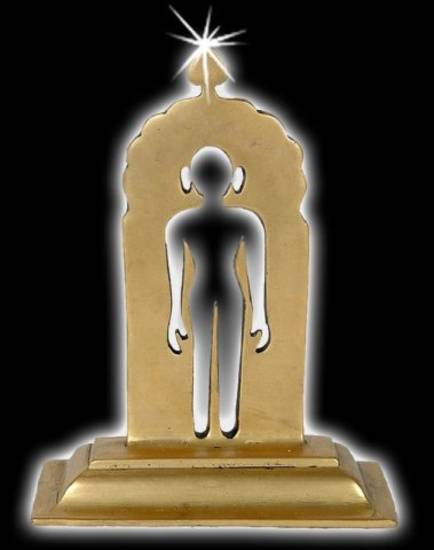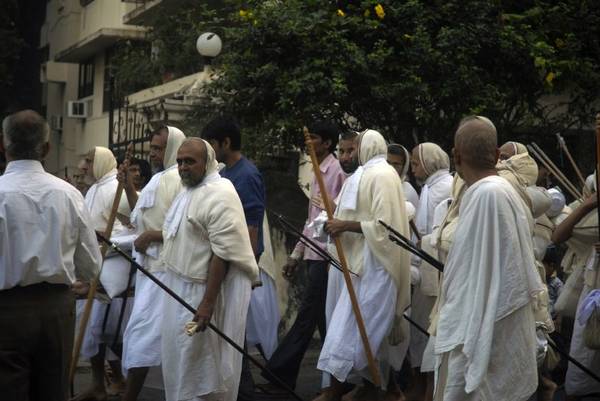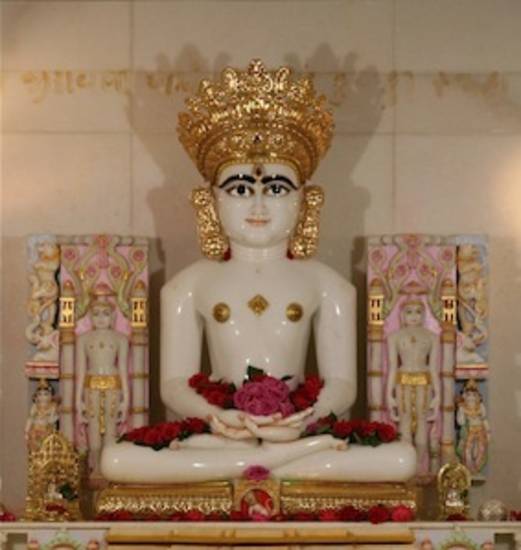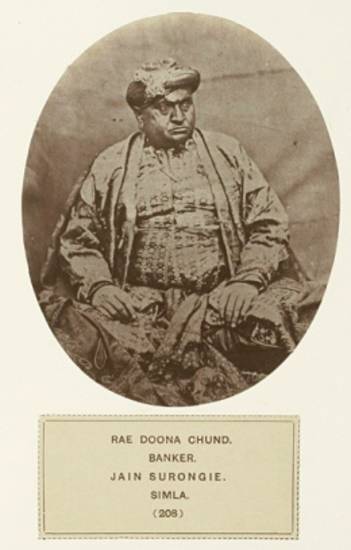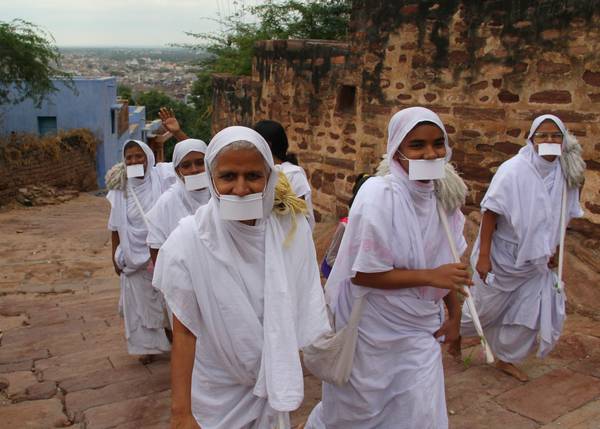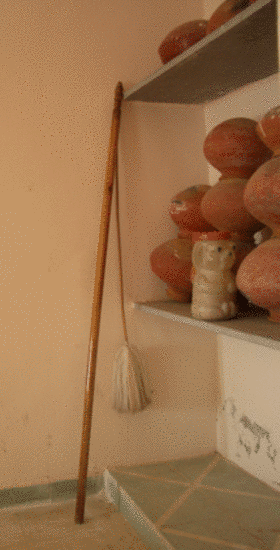Jain beliefs
What is a Jain?
A Jain is someone who accepts the teachings of the Jinas. A Jain believes in Jain principles and tries to act by them in everyday life. These principles form the religion called ‘Jainism’. Most Jains are of Indian ethnicity. The word ‘Jaina’ is an alternative spelling which is less used nowadays in common parlance.
What do Jains believe?
Jains believe that the only way to be rid of the karma that traps the soul in the endless cycle of birth is to follow the teachings of the Jinas. They hold that the path to liberation involves the ‘three gems’:
- the proper view of reality – samyag-darśana
- the proper knowledge – samyag-jñāna
- the proper behaviour – samyak-cāritra.
The proper view of reality demands belief in the truths – tattvas:
- the sentience of the soul, which is found in many physical forms – jīva
- that some things do not have souls – ajīva
- influx of karma to the soul – āsrava
- binding of karma to the soul – bandha
- stopping the influx of karma – saṃvara
- separating existing karma from the soul – nirjarā
- liberation of the soul – mokṣa.
Jains hold that each person is responsible for his or her own spiritual condition. The teachings of the Jinas help those who want to listen to progress towards spiritual enlightenment. Lay people can only advance to the fifth of 14 stages – guṇa-sthāna – while monks and nuns – who renounce the world, as the Jinas did – can progress further. The 15th and final stage is liberation of the soul, which then ascends into the apex of the universe, where it exists in perpetual bliss with other liberated souls – siddha.
Jains believe that each Jina has essentially the same eternal message, which he preaches to the fourfold community he founds. This consists of monks, nuns, lay men and lay women. They pass on his teachings, which can be summarised as the principle of non-violence – ahiṃsā.
Who are the Jinas or Tīrthaṃkaras?
They are human beings who:
- have conquered their passions – kaṣāyas – and attachment to the world
- have reached spiritual enlightenment and omniscience – kevala-jñāna
- teach other people the way to enlightenment
- have liberated their souls from the cycle of rebirth and thus reached mokṣa or nirvāṇa
The word Jina means ‘spiritual victor’ while Tīrthaṃkara means ‘maker of a ford’. Referring to the same people, these Sanskrit terms are titles. The first one describes how a person has successfully battled his natural attachment to the world, including emotions, people and things, to achieve enlightenment. The second term highlights how the enlightened person has built a ford across the river of rebirth so others can follow him to liberation.
Do Jains have a god or gods?
Jinas are not gods but human beings. Liberated souls can be described as supreme souls – paramātman. This word is sometimes thought of as being equivalent to ‘God’ but is not like the monotheistic concept of God familiar in the West. Jains do not believe that a supreme being created the universe or judges people after death. The Jinas, however, are often called ‘Lord’ in English or dev – ‘gods’ – in Indian languages. Jains talk of Rishabhdev for instance. This is because they represent perfection in every way.
Even so, Jains traditionally believe in gods and goddesses because they live in the upper world of the three worlds of Jain cosmology. They are, however, unliberated souls and can only achieve liberation if they are reborn as human beings in the middle world.
Liberated souls are completely detached from the concerns of the world. Even though gods and goddesses have unliberated souls, they have supernatural powers. Deities can intervene in human affairs so some lay Jains may pray to them for help in matters such as health, happiness, fertility and wealth.
Do Jains believe in karma?
Along with other religions such as Hinduism and Buddhism, Jains believe that:
- souls are trapped in the neverending cycle of rebirth – saṃsāra
- souls are reborn in different bodies according to the karma they have collected
- the only way to break out of the cycle of rebirth is to be born a human being, achieve enlightenment and then, leaving the body behind, reach liberation
- souls that have karma attached to them can never be enlightened – the bondage of karma.
The Jain concept of karma is very different from that of the other Indian faiths, however. It is a material that gets stuck to the soul, which is a physical thing.
When was Jainism founded? Who founded it?
Jains believe that each Jina reveals the truth to human beings at different times of spiritual need and thus there is no founder as such of the Jain religion. The first 22 Jinas are known only from legend. The existence of the last two, Pārśvanātha – Lord Pārśva – and Māhavīra, can be historically verified.
The most recent Jina, Māhavīra, is traditionally believed to have lived from 599 / 582 to 527 / 510 BCE. However, modern scholarship dates him as having lived later, from 497 to 425 BCE. Mahāvīra is often viewed as a reformer of certain tenets set out by his predecessor, Pārśva.
Are there different types of Jains?
Just as other religions have different groups within them, so Jainism has several sects, which disagree on certain aspects of doctrine or practice. The two main sects take their names from the appearance of their mendicants.
The monks of the Digambara – ‘sky-clad’ in Sanskrit – sect go naked because they believe that all the Jinas and their male ascetic followers were nude as part of their vow of renunciation. This involves renouncing all possessions, including clothing. Female Digambara ascetics wear white robes and are thus technically inferior to monks.
Monks and nuns in the Śvetāmbara – ‘white-clad’ in Sanskrit – sect wear white clothing.
The difference of opinion over whether the vow of non-possession includes clothing led to the split of the Jain community into these two major sects early in the Common Era. The other chief differences between the two sects are:
- they do not recognise the same scriptures as authoritative
- Śvetāmbaras believe that women can achieve liberation whereas Digambaras do not
- Śvetāmbaras hold that the 19th Jina, Malli, was a woman whereas Digambaras believe that all Jinas are male
- if they are mūrti-pūjaka or idol-worshipping Jains, Śvetāmbara statues of Jinas have open eyes, wear loincloths and are often painted and set in ornately sculpted altars and temples
- Digambara idols have closed eyes, are naked and usually without jewellery and embellishment.
Within the Digambara sect there are the smaller sects of Bīsa-panthin, Terāpanthin and Tāraṇ-panthin. The two newer subsects of the Kavi-panthin, who are followers of Rājacandra, and Kānjī-svāmī-panthin arose in the 20th century.
There are three primary categories of Śvetāmbara Jains – the Mūrti-pūjaka, Sthānaka-vāsin and Terāpanthin. The first group is the largest and consists of several subsects that arose from the medieval period onwards:
- Tapā-gaccha
- Ancala-gaccha
- Kharatara-gaccha
- Pārśvacandra-gaccha
- Pūrṇimā-gaccha.
Divisions can be fierce in practical matters, for example, over the ownership of pilgrimage places, but all sects see themselves as Jains.
Are there any holy books in Jainism?
The teachings of the Jinas were originally passed on through the spoken word. Māhavīra’s disciples memorised his words and their followers had to commit to memory what they were told and so on. Eventually the teachings were written down but the various Jain sects have disputed what makes up the scriptures – or even that any have survived – for centuries.
The Śvetāmbara sect accepts 45 or 32 texts as their canon, depending on their subsect. The sect of the Digambaras believes that all the original scriptures were lost and has a set of texts that were written by later mendicant leaders. These texts are treated as holy scriptures.
What do Jains think of other religions?
Jains believe that other religions can help people to make spiritual progress. They are therefore known for a certain tolerance of other religions.
However, they hold that only following the teachings of the Jinas can reveal the path of spiritual liberation.
Being a Jain
How many Jains are there? Where do they live?
Estimates of the number of Jains in the world range from 5 to 10 million. The vast majority of Jains live in India. They are scattered all over the country, though Digambaras are found chiefly in central and southern India while Śvetāmbaras are concentrated in western India.
Over 100,000 Jains live outside India, with especially large communities in North America, the UK and east Africa. There are around 30,000 Jains in the UK.
What do Jains eat?
Since Jains follow the principle of non-violence – ahiṃsā – they are vegetarians. They do not eat meat or fish or anything else that has a soul or potential life. Traditionally, this includes eggs, root vegetables such as onions and potatoes, and vegetables such as aubergines. Root vegetables are thought to have souls because when a piece of onion, garlic or potato falls to the ground, a new plant can grow. Plants such as aubergine are full of seeds, which each constitute a soul.
Jains eat cheese, yoghurt and other dairy products, rice, bread, lentils and most vegetables and fruit that do not fall into the categories mentioned above. Some contemporary Jains have turned to veganism as they believe that modern farming methods involve violence towards animals.
Do Jains drink alcohol?
Jains do not drink alcohol because it is made from fermented yeast. Yeast is full of microscopic beings that would be harmed if they were drunk. Therefore the principle of non-violence does not allow Jains to drink alcohol.
How do Jains pray?
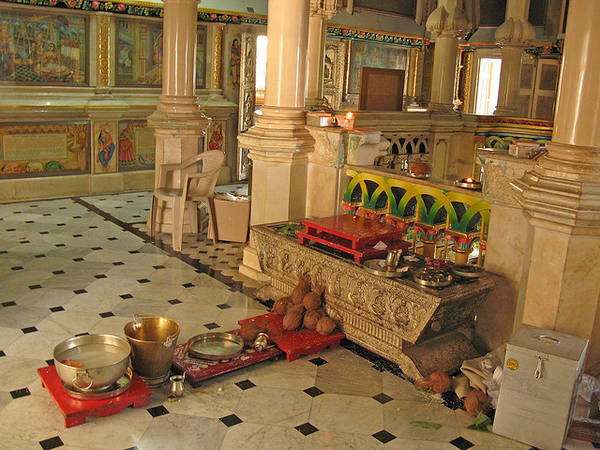
Jain offerings in a temple in Mumbai
Image by Cactusbones – Sue Ann Harkey © CC Attribution-NonCommercial-ShareAlike 2.0
The various sects of Jains worship in different ways. Prayer or worship can be:
- external or material – dravya pūja – which involves objects and substances
- internal or mental – bhāva pūja.
All Jains perform mental worship. The sects that worship images carry out external worship too. However, mendicants of all sects perform only mental worship.
An external worship ceremony may consist of several rites. It frequently includes reciting a mantra or singing a hymn at certain points. Common rituals include that of anointing or bathing a statue with certain substances and placing offerings in front of it. These may include incense, flowers, sweets, fruits, nuts and uncooked rice, often arranged in patterns of auspicious symbols.
When mūrti-pūjaka Jains pray, they do not worship the image itself or a spirit within it or ask for anything. Praying is always joyful and means reverencing the qualities and example of the Jina.
Sthānaka-vāsin Jains, who reject image worship, practise mental worship by reciting prayers and meditating.
The chief prayer for all sects is the Namaskāra-mantra or Navkār-mantra, which is a daily homage to the five types of beings that have reached the highest stages of spirituality.
Do Jains have temples?
Mūrti-pūjaka Jains have temples to hold their idols. The non-mūrtipūjaka sects have mendicant dwelling-halls that are not part of temple complexes.
The local temple is often the centre of the community.
Do Jains have festivals?
Festivals are important to Jains. All sects hold festivals throughout the year, which act to revive faith, strengthen community ties and proclaim religious identity to outsiders. They are also major periods of sustained contact between lay people and monks and nuns and serve as ways of passing on teachings and customs.
All Jain festivals celebrate events in the lives of the Jinas.
What are the most important festivals?
All Jain sects celebrate three festivals each year:
The different Jain sects also hold their own festivals, which may have equivalents in the other sects. For example, the Śvetāmbara festival of Jñāna-pañcamī has a Digambara counterpart in Śruta-pañcamī.
In addition, most communities hold local festivals that commemorate events in the temple or mendicant dwelling-hall or in the lives of monks and nuns. Examples are the installation of a new idol or religious icon in the temple – pratiṣṭhā – and the initiation of a new ascetic – dīkṣā.
Do Jains belong to castes?
Jainism recognises the equality of all souls regardless of the bodies they take. However, as a religion that originated in India and still remains a small minority, Jainism has been heavily influenced by Hindu practices and ideas, including that of caste. Jains reject the Hindu notions of caste being fixed by birth and the supremacy of brahmins but have probably accepted the caste system for a long time. Scholars disagree when Jains adopted the fourfold caste or varṇa system but it is important in Jain legend. For example, Jinas’ parents are always of the kṣatriya caste of warriors and kings, who have the role of ‘protectors’.
In practice, contemporary Jains belong to castes – jātis – like other Indians. This is the social framework that has validity, especially for marriage purposes.
Do Jains do any special jobs?
Honouring the principle of non-violence – ahiṃsā – extends to the jobs that Jains have. They are usually found in occupations that avoid violence, such as trade, medicine, art and clerical jobs.
Jains in business do not take part in commerce that involves violence, such as trading in weapons, timber or charcoal.
Jains who are born in south India often live in rural environments so they practise agriculture.
Contemporary urban Jains often work in professions such as IT, accountancy and the civil service.
Monks and nuns
Why do some Jain monks and nuns wear mouth-cloths? Do all Jains wear them?
Some mendicants use mouth-cloths to avoid harming the one-sensed beings and tiny insects in the air. They may accidentally cause violence by breathing out or inhaling insects.
The monks and nuns of the Śvetāmbara mūrti-pūjaka sects wear mouth-cloths – muhpatti or mukhavastrikā – at certain times. They hold cloths in front of their mouths when preaching or reading scriptures aloud. Mouth-cloths prevent saliva inadvertently flying onto the holy scripture when speaking.
Mendicants of the Sthānaka-vāsin and Terāpanthin sects wear mouth-cloths permanently except when eating. The mouth-cloths are attached to loops of strings that hang over the ears.
Digambara monks and nuns do not use mouth-cloths at all.
Lay Jains may hold cloths over their mouths when carrying out particular ceremonies. They may also attach mouth-cloths when cleaning an idol or performing rituals of worship. These stop saliva accidentally landing on the holy object when they breathe out.
Do Jain monks and nuns take a vow of poverty? What is renunciation?
Renunciation is the general term for taking the special vows to becoming a mendicant for the rest of one’s life. Jains give up the life of the householder – renounce the world – to travel towards higher spiritual conditions, which only fully-fledged monks and nuns can do. They perform the ‘Five Great Vows’ – mahāvratas – which include the vow of non-possession – aparigraha. This means that Jain ascetics do not own anything at all.
Jain monks and nuns do not take a specific vow of poverty, as Christian mendicants do. Their lack of possessions may suggest this, but this condition stems from the vow of non-possession.
If the mendicants are Śvetāmbaras, they use the monastic equipment believed necessary to practise the mendicant life. If they are full Digambara monks, they do not use clothing. Anything monks or nuns need – such as medicine, spectacles and food – they are given by lay people.
Lay people can also take up to 12 vows of renunciation, of varying levels of commitment, but these do not make them mendicants. Only by performing the formal ceremony of renunciation – dīkṣā – does someone become a monk or nun.
Are there any monks and nuns outside India?
There are some monks and nuns outside India but these are few and far between. The vow of non-violence which Jain monks and nuns take means that they move around only on foot, avoiding mechanical forms of transport. Forms of transport such as trains, cars or bicycles commit violence because tiny beings are harmed by their mechanisms and progress. This is also true of transport powered by animals, such as horse carts. Mendicants also cannot properly meet the samiti rules – which revolve around extreme care in daily life – if they take transportation.
The Jain mendicants outside India are mostly samaṇs or samaṇīs, who form a special type of novice mendicant in the Śvetāmbara Terāpanthin sect. Although they have taken the ‘Five Great Vows’ – mahā-vratas – they have been given special permission to use modern methods of communication and transport. They can thus travel outside India and are important among Jain communities round the world, regardless of sect.
A few other mendicants who are not samaṇs or samaṇīs have travelled abroad, and have become famous such as Sushil Muni or Chitrabhanu, but they remain rare cases. Digambara monks have never travelled out of India, but their bhaṭṭārakas, who are clerics and not ascetics, often visit the West.
Do Jains have gurus?
The word guru is a Sanskrit term for a spiritual teacher with great knowledge and wisdom. A guru acts as a guide or leader to followers who seek spiritual and philosophical truths. Thus the term can be used for Jain ācāryas or mendicant leaders.
However, Jains believe that spiritual progress depends upon individual behaviour and attitude. Therefore, although the advice of teachers and leaders is undoubtedly useful, Jains do not usually demonstrate the degree of reverence towards ācāryas that can be seen in other religions. The term is also closely associated with Hinduism and Sikhism and is thus not commonly used among Jains.
Is there an equivalent of the pope in Jainism?
There is no single person in charge of doctrine or practice in Jainism. Only a few of the Jain sects have a central authority, a leading monk who interprets scriptures or gives rulings on new issues. This is the case with the Terāpanthin and the Ancala-gaccha.
Jains and non-Jains
Are you born Jain? Can you convert to Jainism?
The vast majority of Jains are born into Jain families. Anyone can become a Jain if he or she accepts the teachings of the Jinas. Story literature abounds in examples of characters from other creeds, such as Hinduism or Buddhism, who met a Jain teacher and thus adopted ‘right faith’ and renounced worldly life. On a larger scale there are several instances of group conversions to Jainism that took place among warrior castes in medieval Rajasthan.
Jains do not try to convert non-believers to the Jain faith. They hold that all religions contain elements of the truth and can thus help people to advance along the path to final liberation.
In modern times, there have been isolated attempts to convert poor Indian communities to Jainism, but the purpose is more to promote Jain values in general.
Can non-Jains visit temples?
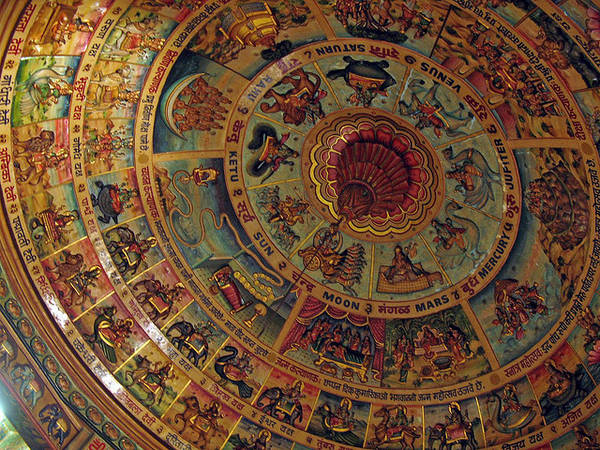
Heavenly entities and gods decorate a temple ceiling
Image by Cactusbones – Sue Ann Harkey © CC Attribution-NonCommercial-ShareAlike 2.0
Anyone can visit a Jain temple. Jains are usually happy to welcome people who are interested in their faith. There have, however, been debates in India about members of the dalit or ‘untouchable’ caste entering Jain temples.
Most working temples are open for prayer in the mornings.
Visitors to Jain temples should remove their shoes before going inside, as the worshippers do.



